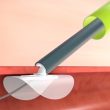Surgical risk scores cannot be used for transcatheter aortic valve replacement (TAVR) and they usually overestimate procedural risk. There are 5 big complications after TAVR, specifically, that cannot be predicted by conventional surgical scores. These 5 peri-procedural complications are considered important because they have a somewhat significant impact on survival after TAVR. They are: 1)<a href="https://solaci.org/en/2019/04/01/we-must-still-fear-the-big-five-complications-after-tavr/" title="Read more" >...</a>
Transcarotid Approach for Transfemoral in TAVR
Courtesy of Dr. Carlos Fava. At present, the transfemoral is the preferred access site in TAVR, for it has been shown to present fewer complications. However, whenever not feasible, we can resort to other approaches. These include the subclavian, the transapical, the transcaval, the transaortic, and the transcarotid. This last one has been studied few<a href="https://solaci.org/en/2019/03/15/transcarotid-approach-for-transfemoral-in-tavr/" title="Read more" >...</a>
The Most Relevant Articles of 2018 in Peripheral Vascular Disease
1- What’s New in the European Guidelines on Peripheral Arterial Disease Since the last version of the European guidelines on the diagnosis and treatment of peripheral arterial disease in 2011, there have been many trials and registries that warrant guideline adjustments in many aspects. The first novelty is the teamwork that gave way to these<a href="https://solaci.org/en/2019/02/04/the-most-relevant-articles-of-2018-in-peripheral-vascular-disease/" title="Read more" >...</a>
The Physiopathology Behind Valve Degeneration in TAVR
The degeneration of transcatheter biological valves clearly depends on time and starts with thrombus generation and subsequent histological changes resulting in valve failure (due to regurgitation, stenosis, or both). Thrombus formation is the first change, observed early in computerized tomography (CT) scans after implantation. Most times it is completely asymptomatic, which leaves many of us<a href="https://solaci.org/en/2019/01/18/the-physiopathology-behind-valve-degeneration-in-tavr/" title="Read more" >...</a>
Percutaneous Closure Systems Are Safe in TAVR and Aneurysms
Courtesy of Dr. Carlos Fava. Currently, one of our medical challenges is to conduct procedures requiring access with large introducer sheaths in a simpler way, without requiring surgical intervention and closing with percutaneous devices while maintaining procedural quality and safety. There are several devices, but they require a learning curve and the only information available comes<a href="https://solaci.org/en/2019/01/15/percutaneous-closure-systems-are-safe-in-tavr-and-aneurysms/" title="Read more" >...</a>
The 10 Most Read Articles of December
1- Everolimus-Eluting Stents Finally Have a Rival and Not Just a “Non-Inferior” Stent In this large randomized trial, there were significant differences as regards both target-lesion failure and target-vessel-related infarction, which persisted through a 2-year follow-up and favored treatment with an ultrathin-strut bioresorbable-polymer sirolimus-eluting stent (Orsiro) compared with the gold standard, a durable-polymer everolimus-eluting stent<a href="https://solaci.org/en/2019/01/04/the-10-most-read-articles-of-december/" title="Read more" >...</a>
New Atrial Fibrillation After TAVR Indicates Prognosis
Courtesy of Dr. Carlos Fava. Transcatheter aortic valve replacement (TAVR) has emerged as an important treatment alternative for intermediate- and high-risk patients. In that sense, the presence of atrial fibrillation (AF) before TAVR is high and it has been associated with worse outcomes and higher mortality. However, there is not much evidence available regarding new-onset atrial<a href="https://solaci.org/en/2018/10/01/new-atrial-fibrillation-after-tavr-indicates-prognosis/" title="Read more" >...</a>
Mitral Valve Repair in Patients with Cardiac Failure
The mitral valve is a complex apparatus dependent on left atrium and left ventricle functionality. Dilation of these cavities might affect mitral annulus morphology and lead to valve dysfunction, generating mitral regurgitation (MR). This type of MR has been called functional, since leaflets and tendinous chordae do not present lesions themselves; instead, they malfunction ‘secondary’<a href="https://solaci.org/en/2018/10/01/mitral-valve-repair-in-patients-with-cardiac-failure/" title="Read more" >...</a>
See the presentations of the 9th José Gabay Fellow Course
We are deeply thankful to all interventional physicians who, motivated by their great scientific and educational vocation, presented their works at the “José Gabay” Course. Read the presentations below: Module I: Fundamentals and Basic Elements. Leiva Pons, José Luis. “Vascular Closure Devices. Step by Step.” (Spanish version) García García, Hector. “Current Status of Coronary Intervention:<a href="https://solaci.org/en/2018/09/14/see-the-presentations-of-the-9th-jose-gabay-fellow-course/" title="Read more" >...</a>
EuroPCR 2018 | SAPIEN 3 in bicuspids
First generation TAVR procedures performed on patients with bicuspid aortic valve stenosis have rendered suboptimal outcomes. In addition, studies on new generation devices, such as the SAPIEN 3, have systematically excluded these patients from their protocols. Therefore, we are missing information about TAVR on bicuspid aortic valve stenosis patients. This study compared SAPIEN 3 TAVR<a href="https://solaci.org/en/2018/05/30/europcr-2018-sapien-3-in-bicuspids/" title="Read more" >...</a>









